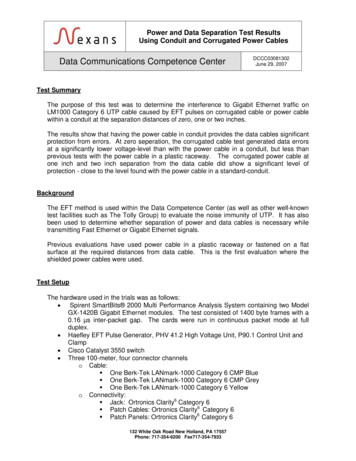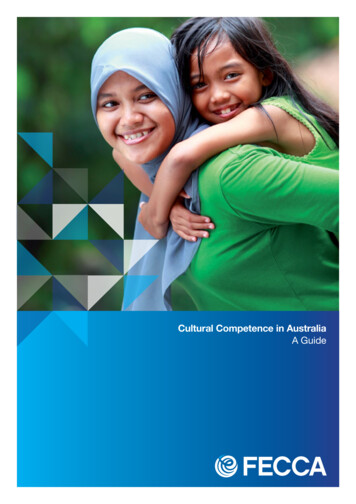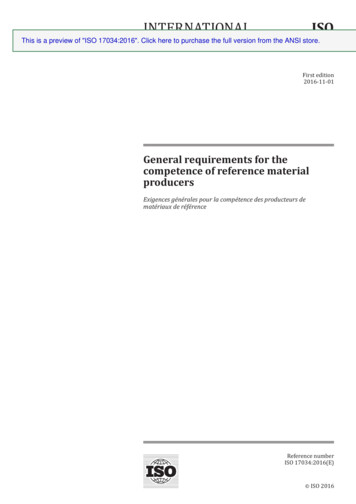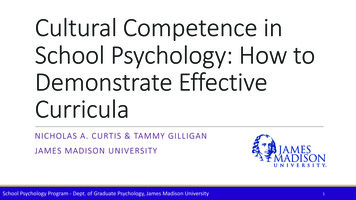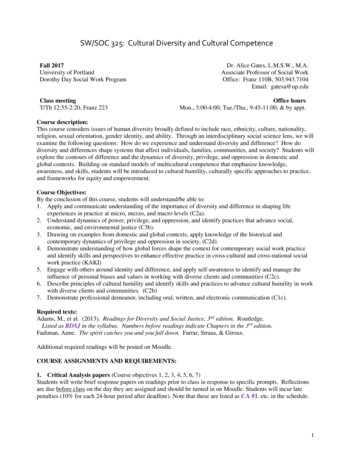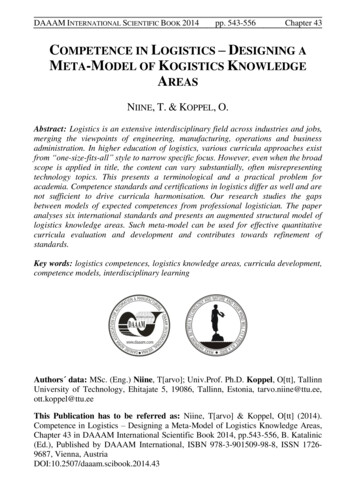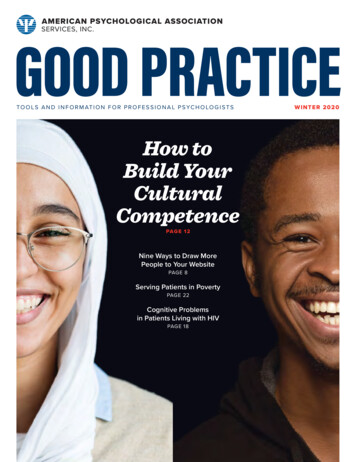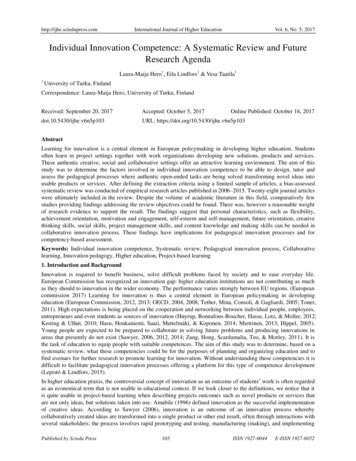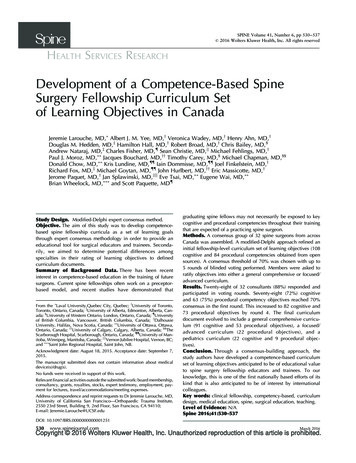
Transcription
SPINE Volume 41, Number 6, pp 530–537ß 2016 Wolters Kluwer Health, Inc. All rights reservedHEALTH SERVICES RESEARCHDevelopment of a Competence-Based SpineSurgery Fellowship Curriculum Setof Learning Objectives in CanadaJeremie Larouche, MD, Albert J. M. Yee, MD,y Veronica Wadey, MD,y Henry Ahn, MD,yDouglas M. Hedden, MD,z Hamilton Hall, MD,y Robert Broad, MD,y Chris Bailey, MD,§Andrew Nataraj, MD,z Charles Fisher, MD,{ Sean Christie, MD,jj Michael Fehlings, MD,yPaul J. Moroz, MD, Jacques Bouchard, MD,yy Timothy Carey, MD,§ Michael Chapman, MD,§§Donald Chow, MD, Kris Lundine, MD,{{ Iain Dommisse, MD,{{ Joel Finkelstein, MD,yRichard Fox, MD,z Michael Goytan, MD,{{ John Hurlbert, MD,yy Eric Massicotte, MD,yJerome Paquet, MD,y Jan Splawinski, MD,jjjj Eve Tsai, MD, Eugene Wai, MD, Brian Wheelock, MD, and Scott Paquette, MD {Study Design. Modified-Delphi expert consensus method.Objective. The aim of this study was to develop competencebased spine fellowship curricula as a set of learning goalsthrough expert consensus methodology in order to provide aneducational tool for surgical educators and trainees. Secondarily, we aimed to determine potential differences amongspecialties in their rating of learning objectives to definedcurriculum documents.Summary of Background Data. There has been recentinterest in competence-based education in the training of futuresurgeons. Current spine fellowships often work on a preceptorbased model, and recent studies have demonstrated thatFrom the Laval University,Quebec City, Quebec; yUniversity of Toronto,Toronto, Ontario, Canada; zUniversity of Alberta, Edmonton, Alberta, Canada; §University of Western Ontario, London, Ontario, Canada; {Universityof British Columbia, Vancouver, British Columbia, Canada; jjDalhousieUniversity, Halifax, Nova Scotia, Canada; University of Ottawa, Ottawa,Ontario, Canada; yyUniversity of Calgary, Calgary, Alberta, Canada; §§TheScarborough Hospital, Scarborough, Ontario, Canada; {{University of Manitoba, Winnipeg, Manitoba, Canada; jjjjVernon Jubilee Hospital, Vernon, BC;and Saint John Regional Hospital, Saint John, NB.Acknowledgment date: August 18, 2015. Acceptance date: September 7,2015.The manuscript submitted does not contain information about medicaldevice(s)/drug(s).No funds were received in support of this work.Relevant financial activities outside the submitted work: board membership,consultancy, grants, royalties, stocks, expert testimony, employment, payment for lectures, travel/accommodations/meeting expenses.Address correspondence and reprint requests to Dr Jeremie Larouche, MD,University of California San Francisco—Orthopaedic Trauma Institute,2550 23rd Street, Building 9, 2nd Floor, San Francisco, CA 94110;E-mail: Jeremie.Larouche@UCSF.edugraduating spine fellows may not necessarily be exposed to keycognitive and procedural competencies throughout their trainingthat are expected of a practicing spine surgeon.Methods. A consensus group of 32 spine surgeons from acrossCanada was assembled. A modified-Delphi approach refined aninitial fellowship-level curriculum set of learning objectives (108cognitive and 84 procedural competencies obtained from opensources). A consensus threshold of 70% was chosen with up to5 rounds of blinded voting performed. Members were asked toratify objectives into either a general comprehensive or focused/advanced curriculum.Results. Twenty-eight of 32 consultants (88%) responded andparticipated in voting rounds. Seventy-eight (72%) cognitiveand 63 (75%) procedural competency objectives reached 70%consensus in the first round. This increased to 82 cognitive and73 procedural objectives by round 4. The final curriculumdocument evolved to include a general comprehensive curriculum (91 cognitive and 53 procedural objectives), a focused/advanced curriculum (22 procedural objectives), and apediatrics curriculum (22 cognitive and 9 procedural objectives).Conclusion. Through a consensus-building approach, thestudy authors have developed a competence-based curriculumset of learning objectives anticipated to be of educational valueto spine surgery fellowship educators and trainees. To ourknowledge, this is one of the first nationally based efforts of itskind that is also anticipated to be of interest by internationalcolleagues.Key words: clinical fellowship, competency-based, curriculumdesign, medical education, spine, surgical education, teaching.Level of Evidence: N/ASpine 2016;41:530–537DOI: mMarch 2016Copyright 2016 Wolters Kluwer Health, Inc. Unauthorized reproduction of this article is prohibited.
HEALTH SERVICES RESEARCHTDevelopement of a Competence-Based Spine Fellowship Larouche et alhe field of spine surgery has advanced rapidly overthe past 2 decades. With new technologies and newprocedures, the breadth and scope of the practice of aspine surgeon has become so broad that it can no longer becovered adequately during the course of residency training.1Combined with new residency duty hours restriction thatare in effect in the United States (U.S.), the United Kingdom(U.K.), and now in Canada, this has led many to questionwhether residents are truly ready to enter practice upongraduating from surgical residencies,1–4 and even whetherspine surgery should become its own surgical residency.5Sub-specialization fellowships have and continue to play animportant role in ensuring that surgeons obtain the highestquality of training so that they may in turn provide exceptionalpatient care within a specific area of surgery. After graduatingfrom a fellowship, the expectation is that a surgeon will becompetent in performing a variety of elective procedures, aswell as to manage a multitude of surgical emergencies andcomplications. However, fellowships are not uniform. Manyspine surgery fellowships function on a preceptorship basis,where mentors may have a particular interest in fields such asdeformity, trauma, or degenerative disease. This does notnecessarily reflect a more general spine practice that fellowsmay encounter upon entry into independent practice. A surveyby Konczalik et al1 demonstrated significant variability insurgeons’ self-reported confidence in performing various coreprocedures following spine fellowship training in Europe. Theyconcluded that ‘‘there is a considerable variation in the competency of post-fellowship spinal surgeons in the managementof frequently encountered spinal conditions’’ and raise the issueof ‘‘a lack of uniformity in the surgical curriculum’’.1 Malempati et al6 recently performed a similar study in Canadasurveying spine fellows upon graduation to assess their selfperceived competence at performing 29 key procedures independently. Of those procedures, fellows indicated being comfortable in independently performing 12 of the 29, requiring ‘‘alittle more training’’ for 13 procedures, and ‘‘some more training’’ for the remaining 4.Herkowitz et al,7 through the North American SpineSociety (NASS), highlighted the importance of a fellowshipeducational curriculum among other factors that traineesshould consider in selecting a clinical fellowship.8 To date,there is limited published literature on spine surgery fellowship education and there remains an important need todevelop and validate educational curricula including evaluation methods on the acquisition of clinical skills. Theestablishment of a nationally based education curriculaset of learning objectives at the spine surgery fellowshiplevel was the primary purpose of this study. This wasconsidered a key goal toward enhancing education, including research in education. Secondarily, we aimed to determine potential differences among specialties in their ratingof learning objectives to defined curriculum documents.of the scientific literature. We obtained these objectives byevaluating educational and continuing medical educationmaterials available through training programs, international spine societies, as well as physician surgical accreditation organizations. Objectives were also included on thebasis of perceived gaps in training syllabi as deemed appropriate by expert group members. An initial list of fellowshiptraining objectives included 108 cognitive and 84 procedural competency objectives.A consensus group of 32 academic and community spinesurgeons was established through the Canadian SpineSurgery (CSS) Education Committee (Chair author S.P.).This group was composed of neurosurgeons and orthopedicsurgeons whose practice consisted of at least 80% spinesurgery, and represented national academic and communityinterest. Table 1 provides further description of the expertgroup’s composition and experience. The expert groupdefined a priori several terms that were used to evaluatethe listed objectives (Table 2).A modified-Delphi expert method was employed and theinitial list of training objectives was voted upon anonymouslyusing an online electronic ballot (SurveyMonkey). After eachround of voting, learning goals that achieved 70% consensuson a defined rating scale (Table 2) were eliminated, transferred to the comprehensive fellowship curriculum, or to thefocused/advanced fellowship curriculum.9 Those that failedto reach consensus were discussed and revised before beingsubmitted to the next round of voting, until a 70% consensusagreed to the modification. A maximum of 5 rounds wasagreed upon before the commencement of ratification. Onceall objectives were assigned to their respective subcategory,the expert group ratified curricula documents as a whole.Statistical analysis was performed by a biostatistician(J.C.V.) using SAS v9.4 (Cary, NC). Between our neurosurgicaland orthopedic respondents, we compared the distribution ofsurgical practice type, fellowship/program director status, andgeographic region of practice by province (Fisher’s exact test).We also compared years in clinical practice and number ofclinical fellows trained (Wilcoxon rank-sum test). We thenanalyzed for potential differences in how respondents initiallyrated each cognitive and procedural objective comparingorthopedic with neurosurgical respondents (Fisher’s exact test).A grouped analysis of cognitive (e.g., trauma, oncology, etc.)and procedural (e.g., cervical, thoracic, etc.) ratings was alsoperformed comparing specialty background (Bonferroni corrected non-parametric Wilcoxon rank-sum tests looking for adifference in the distribution of responses). We determinedpotential differences in initial responses comparing cognitiveversus procedural domains as well as comparing pediatricversus adult domains (Bonferroni corrected nonparametricWilcoxon rank-sum tests looking for a difference in the distribution of responses). Statistical significance was set at P 0.05.MATERIALS AND METHODSTwenty-eight of 32 expert members (88% response rate)responded to and participated in voting rounds (Table 1).Seventy-eight (72%) cognitive and 63 (75%) proceduralA list of cognitive and procedural learning objectives pertinent to spine surgery fellowship was generated by a reviewSpineRESULTSwww.spinejournal.com531Copyright 2016 Wolters Kluwer Health, Inc. Unauthorized reproduction of this article is prohibited.
HEALTH SERVICES RESEARCHDevelopement of a Competence-Based Spine Fellowship Larouche et alTABLE 1. Demographics Expert Group by SpecialtyOverall N ¼ 28Practice, n (%)CommunityCombinedAcademicDirector, n (%)YesNoProvince/Region ofPracticeYears in practice, median(IQR)Number of fellows in last5 years, median (IQR)Orthopedics N ¼ 17Neurosurgery N ¼ 11P0.271 3 (10.7)3 (10.7)22 (78.6)3 (17.7)1 (5.9)13 (76.5)0 (0.0)2 (18.2)9 (81.8)0.700 13 (46.4)15 (53.6)287 (41.2)10 (58.8)176 (54.6)5 (45.4)110.110 16.5 (10.0–25.5)18.0 (12.0–26.0)11.0 (8.0–22.0)0.168y5.0 (1.5–18.0)5.0 (2.0–12.0)8.0 (1.0–20.0)0.575yExpertise also included spine surgery fellowship program directors and supervisors, surgical educators with education research expertise, and practicing spinesurgeons with concomitant leadership roles at Canadian universities, the Canadian Spine Society (CSS), the Canadian Orthopaedic Association (COA), theCanadian Neurosurgical Society/Canadian Neurologic Sciences Federation (CNSS/CNSF), and the Royal College of Physicians and Surgeons of Canada(RCPSC) Committee of Specialties (COS).IQR indicates interquartile range. Fishers exact test.yNonparametric Wilcoxon rank-sum test.competency objectives reached 70% consensus in the firstround. By the fourth round, a total of 82 (76%) cognitiveand 73 (87%) procedural objectives reached 70% consensus(Figure 1). Fifty-eight percent of the pediatric objectivesremained unresolved after 4 rounds of voting. Throughconsensus agreement following additional group discussion,members recommended the creation of a separate pediatricscurriculum (with recommendation that the 3 initialpediatric cognitive objectives ratified to the comprehensivecurriculum appear in both comprehensive and pediatriccurriculum documents, and the 7 items recommended forinitial inclusion in the focused/advanced curriculum betransferred over to the pediatric curriculum). Five additionalpediatric cognitive (communication, informed consent, andprognosis) and procedural (infection, trauma) objectiveswere also developed and recommended to be included inthe pediatric curriculum based upon discussion. Duringvoting rounds 2 through 4, 5 adult cognitive objectives werereworded and 1 additional cognitive item was developedand ratified to the comprehensive curriculum.Excluding the pediatric objectives discussed above, therewere 5 cognitive and 7 procedural objectives that did not reach70% consensus after 4 voting rounds (Table 3). There wasconsensus agreement that all 12 remaining objectives should beincluded and not excluded in curriculum documents and therefore the final round ratified these remaining objectives to theappropriate curriculum category using a majority vote ( 50%consensus; Table 3). Final curriculum documents developedinclude a general comprehensive curriculum (91 cognitive and53 procedural objectives; Appendix A, http://links.lww.com/BRS/B55), a focused/advanced curriculum (22 proceduralobjectives; Appendix B, http://links.lww.com/BRS/B55), anda pediatrics curriculum (22 cognitive and 9 procedural objectives; Appendix C, http://links.lww.com/BRS/B55).Statistically, there were several interesting observationswhen evaluating initial survey replies comparing respondents by background specialty training (Table 4). In someneurologic-related cognitive objectives (e.g., recognition ofnonsurgical and surgical spinal cord syndromes, medicalmanagement in spinal cord injury, oncologic conditionsTABLE 2. A Priori Definitions for Rating of Cognitive and Procedural Learning ObjectivesLearning Objectives Rating Scale—A Priori DefinitionsA training objective not appropriate for fellowship curriculumA training objective appropriate for a comprehensive fellowshipcurriculumA training objective appropriate for a focused/advancedfellowship curriculum532www.spinejournal.comAn objective that is not appropriate at the fellowship level forthe training of a Spine Surgeon in Canada and/or acompetency that should have been attained during medicalschool or surgical residency.Objective appropriate and considered an important competencyto be gained during spine fellowship training.Objective considered advanced by nature of the cognitive orprocedural competency to be achieved and will required afocused exposure at a tertiary/quaternary center and/orspecialized advanced surgical skills courses to acquirecompetency.March 2016Copyright 2016 Wolters Kluwer Health, Inc. Unauthorized reproduction of this article is prohibited.
HEALTH SERVICES RESEARCHFigure 1. A flow map demonstrating the results of Expert Consensusvoting in the development of Fellowship Curricula Set of LearningObjectives. Workflow demonstrating the creation of 3 separate curricula using the Delphi method.including those involving neural tissues), respondents ofneurosurgical background were more likely to recommendthese objectives as either not appropriate for fellowshiptraining (e.g., should be acquired during residency training)or for inclusion in the general comprehensive curriculum.Orthopedic respondents, however, were more likely toinitially recommend inclusion of objectives into either thegeneral comprehensive or focused/advanced curriculum.This trend direction comparing specialty background wasalso observed with grouped analyses of cognitive objectives(Table 5, oncology/vascular (P ¼ 0.034) as well as degenerative spine (P ¼ 0.033) areas).A similar pattern was also observed for some individualprocedural objectives as well, for example, those relating toDevelopement of a Competence-Based Spine Fellowship Larouche et althe use of operative magnification or navigation, selectcervical spine procedures, and procedures managingprimary neural tumors (Table 4, P 0.05). This was alsoconsistent with grouped analyses of procedural objectives(Table 5, cervical spine (P 0.001), and oncology(P ¼ 0.035)).In general, respondents of both specialties were morelikely to recommend the inclusion of procedural (vs. cognitive) as well as pediatric (vs. adult) related objectives ontheir initial survey reply for inclusion in the focused/advanced category (P 0.001). During the final round ofvoting on 12 remaining objectives, there was a differencecomparing neurosurgical with orthopedic response in cognitive competency relating to spinal vascular conditions(P ¼ 0.05) and procedural competency relating to spinalosteotomies (P ¼ 0.02). For both these competencies, orthopedic surgeons tended to recommend inclusion in thefocused/advanced category when compared with neurosurgeons who tended to recommend inclusion into the generalcomprehensive category.DISCUSSIONTwo recent trends have motivated the development of acompetence-based spine surgery fellowship education curriculum in Canada. Firstly, surgical residency training inNorth America is rapidly changing. With a successful legalchallenge in Quebec, many provinces are now looking toimplement more stringent work hour restrictions withintheir residency-training programs (Arbitration Board: Canada, Province of Quebec. McGill University Health Centreand Association des Resident de McGill Arbitration Award,June 7, 2011). Similarly, after the implementation of thelatest resident supervision and duty-hour regulations fromTABLE 3. List of Cognitive and Procedural Objectives Requiring Majority Ratification on Final5th Voting RoundCognitive ObjectivesRecognize and demonstrate knowledge of the surgical treatment required to manage spino-pelvic dissociation.Demonstrate the ability to recognize spinal vascular malformations, such as arteriovenous malformations, dural arterio-venousfistula, and hemangiomas, including knowledge of treatment options for spinal vascular conditions.Recognize and know how to facilitate the treatment of common pain conditions that may be referred to spine surgeons, such asfibromyalgia, complex regional pain, and chronic neuropathic pain.Demonstrate the ability to assess a patient’s return to work and physical activities, including the ability to manage the medicolegal requests made by third parties.Demonstrate knowledge of concepts specific to research in the spine, both surgical and nonsurgical conditions. These includethe development of a research question, hypotheses and specific aims, knowledge of study design, interpretation, and criticalevaluation of the spine literature.Procedural ObjectivesDemonstrate the ability to perform a cervical disc arthroplasty.Demonstrate proficiency in managing both sagittal and coronal plane deformities of the thoracic spine with instrumentation.Demonstrate the ability to perform slip or angular reduction for spondylolisthesis and spondyloptosis.Demonstrate proficiency in the use of minimally invasive spine surgery techniques (i.e., tubular systems).Demonstrate the ability to perform a XLIF (extreme la
Brian Wheelock, MD, and Scott Paquette, MD{Study Design. Modified-Delphi expert consensus method. Objective. The aim of this study was to develop competence-based spine fellowship curricula as a set of learning goals through expert consensus methodology in order to provide an educa

